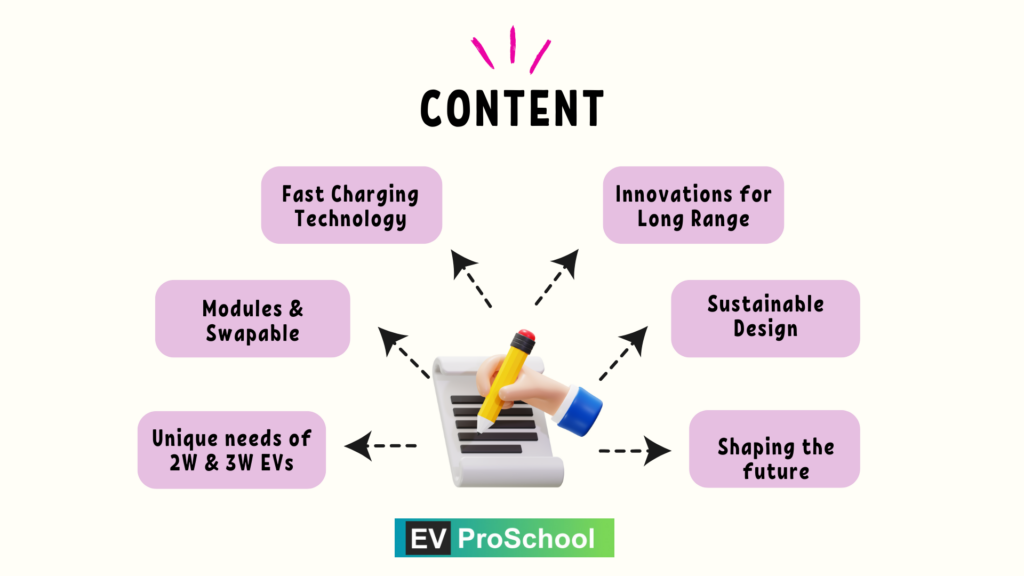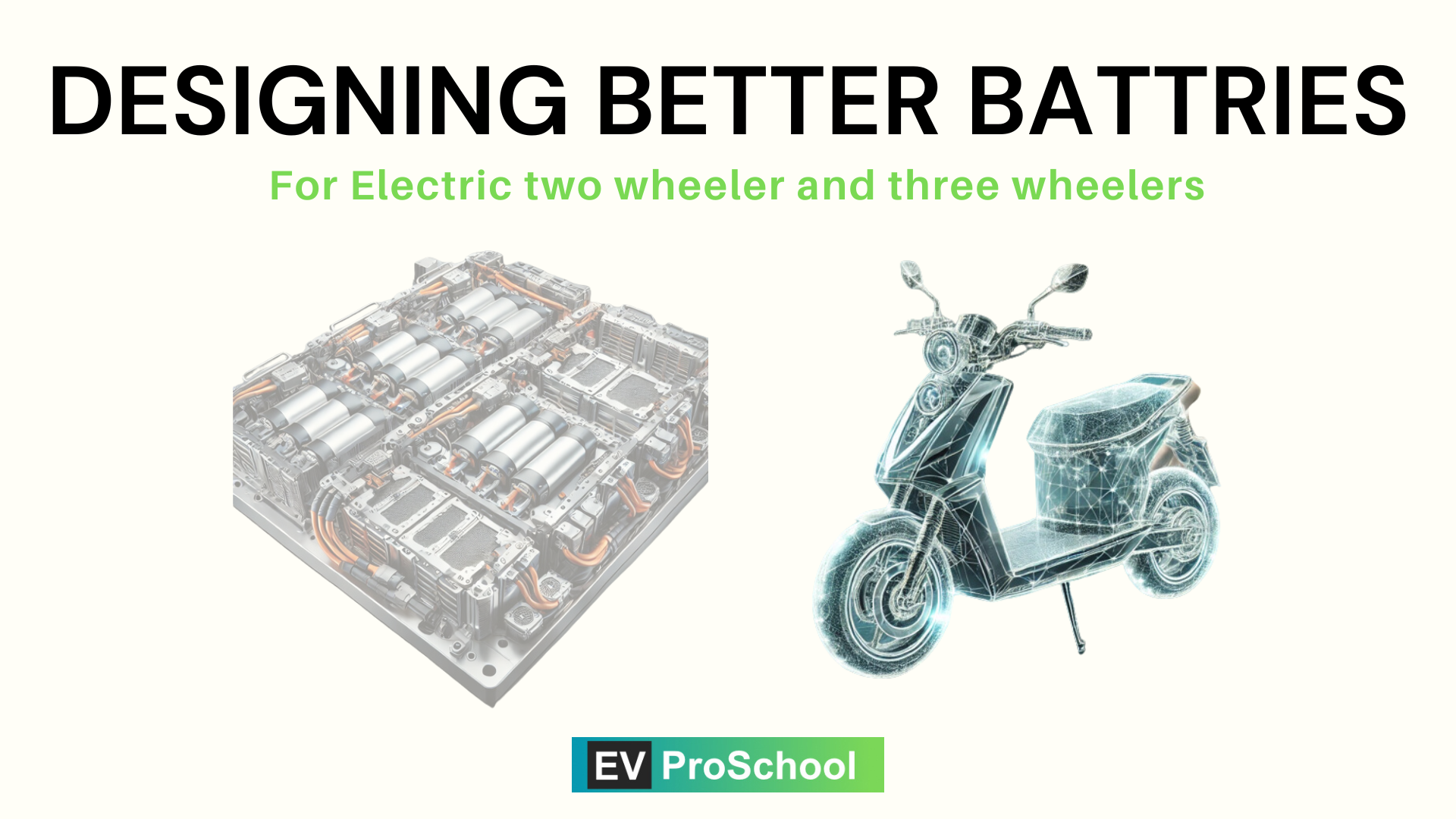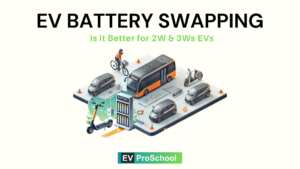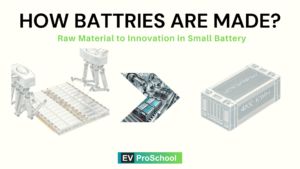Detailed Strategy for Blog Post: “Designing Better Batteries for Electric 2W and 3W”
This blog post will focus on designing advanced batteries tailored specifically for el/ectric two-wheelers (2W) and three-wheelers (3W), emphasizing innovations, future technologies, and customization for diverse use cases. It will avoid repeating manufacturing processes, assembly techniques, or material basics discussed in previous posts and instead highlight how innovative designs improve efficiency, affordability, and usability for these small electric vehicles.

1. Objectives
Purpose:
- To showcase innovative battery designs that optimize performance for 2W and 3W EVs.
- Highlight how batteries are tailored to meet the specific needs of urban mobility, delivery services, and passenger transport.
- Explore breakthroughs in energy density, compactness, modularity, and cost-efficiency.
2. Key Topics
Core Focus:
- Specialized Battery Features for 2W and 3W: Lightweight, durable, compact, and high-power designs.
- Innovative Designs: Modular batteries, swappable systems, and fast-charging capabilities.
- Future Trends: Advancements in solid-state technology, ultra-fast charging, and cobalt-free chemistries.
SEO Focus Keyword:
“Better batteries for 2W and 3W EVs”
Supporting Keywords:
- Modular battery designs for electric vehicles
- Fast-charging batteries for 2W/3W
- Lightweight EV batteries
- Innovations in small EV battery technology
3. Blog Outline
Title Options:
- Main Title: Designing Better Batteries for Electric 2W and 3W
- SEO-Friendly Title: Revolutionizing Small EV Batteries: Designing for Efficiency and Cost
Introduction: Powering the Future of Small EVs
- Hook:
“Electric two-wheelers and three-wheelers are transforming urban mobility, but their true potential lies in the batteries that power them.” - Highlight the importance of tailored battery designs for addressing specific challenges:
- Compactness and lightweight for maneuverability.
- Affordability for mass adoption in cost-sensitive markets.
- Fast-charging and swappable systems for convenience.
- Preview the post: “This blog explores the latest innovations and trends in designing better batteries for small electric vehicles.”
Section 1: Designing for the Unique Needs of 2W and 3W EVs
1. Compact and Lightweight Batteries
- Small EVs prioritize agility and range over bulk power.
- Strategies for compact designs:
- Using pouch cells for flexibility and space efficiency.
- Optimizing energy density to maximize range without increasing size.
2. Cost Optimization
- Why it’s critical: 2W and 3W EVs are dominant in developing markets, where affordability is key.
- Innovations driving cost reduction:
- Transitioning to cobalt-free chemistries like LFP (Lithium Iron Phosphate).
- Utilizing recycled materials without compromising performance.
Section 2: Modular and Swappable Battery Systems
1. Benefits of Modular Designs
- Customization: Adaptable battery packs based on usage (e.g., smaller packs for personal scooters, larger ones for delivery services).
- Maintenance: Damaged modules can be replaced without discarding the entire battery pack.
2. Swappable Batteries
- Ideal for fleets and public transport.
- Case Study:
- Bounce Infinity and Ola’s Swappable Batteries for 2W EVs.
- E-rickshaws in India adopting swappable designs for continuous operation.
Section 3: Enhancing Performance with Fast-Charging Technology
1. Challenges of Fast Charging
- Overheating risks and battery degradation with high-speed charging.
2. Solutions:
- Silicon-Anode Technology: Improves charge rates without compromising cycle life.
- Thermal Management: Advanced cooling systems for small EV batteries.
3. Real-World Example:
- Fast-charging 2W batteries from Ather Energy (charges up to 80% in ~60 minutes).
Section 4: Innovations for Range and Longevity
1. Solid-State Batteries
- Higher energy density and safety compared to lithium-ion.
- Potential to revolutionize small EV batteries by reducing weight and increasing lifespan.
2. Dual-Chemistry Packs
- Hybrid designs combining LFP (for durability) and NMC (for energy density).
3. Smart Battery Management Systems (BMS)
- Features: Real-time monitoring, predictive maintenance, and optimization of battery usage based on driving patterns.
Section 5: Sustainable Battery Design
1. Recycling-Friendly Designs
- Modular batteries make it easier to recover and reuse materials like lithium and nickel.
2. Solar Charging Integration
- Incorporating solar panels into small EVs to support off-grid charging, especially in rural areas.
Conclusion: Shaping the Future of 2W and 3W EV Batteries
- Recap the importance of designing batteries that balance performance, affordability, and sustainability.
- Emphasize the role of innovation in driving small EV adoption in urban and rural markets.
- End with a call-to-action: “Stay updated on the latest in EV battery technology by exploring our guides on advanced materials and efficient battery designs.”
4. Writing Style and Tone
- Tone: Forward-looking and engaging, appealing to both technical readers and general EV enthusiasts.
- Use comparisons to explain concepts:
- “Think of modular batteries like building blocks—you can add or remove pieces based on the specific needs of your vehicle.”
5. Suggested Visuals and Graphics
- Diagram: Modular battery pack structure showing swappable cells.
- Infographic: Comparison of fast-charging vs traditional charging for small EV batteries.
- Chart: Projected impact of solid-state batteries on 2W/3W range and cost.
- Case Study Spotlight: Image of a swappable battery station for 3W e-rickshaws in India.
6. SEO Optimization Strategy
Focus Keyword:
“Better batteries for 2W and 3W EVs”
Supporting Keywords:
- Modular battery design for 2W/3W
- Fast-charging technology for small EVs
- Swappable batteries for electric vehicles
- Lightweight battery packs
Meta Description:
“Discover how innovative designs are shaping better batteries for electric 2W and 3W EVs. Explore modular systems, fast-charging technology, and sustainable solutions for small EVs.”
Alt Text for Feature Image:
“Modular battery design for electric 2W and 3W vehicles with swappable cells and fast-charging features.”
7. Blog Length and Target Audience
- Word Count: 1,800–2,200 words to ensure comprehensive coverage of advanced battery design strategies.
- Target Audience: EV enthusiasts, engineers, policymakers, and professionals in the electric mobility sector.
By avoiding repetition from previous posts and focusing on cutting-edge innovations, modularity, and cost optimization, this strategy ensures a fresh and engaging perspective on designing better batteries for electric 2W and 3W vehicles.



